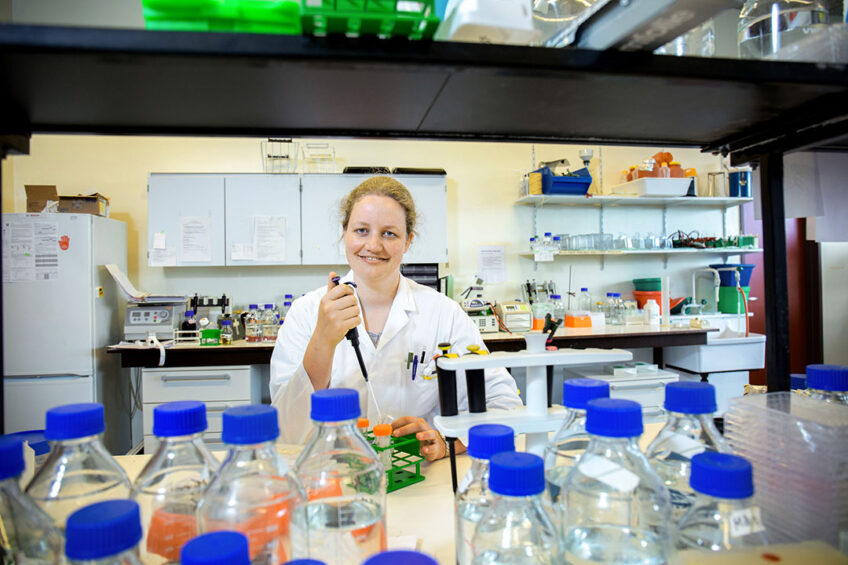12 alternative AMR management strategies for dairy herds

Antimicrobial resistance (AMR) is a major concern for the dairy industry, but what can be done against it? We list 12 strategies to tackle AMR.
Chetan Sharma et al. set out to answer this question in their research titled Antimicrobial Resistance: Its Surveillance, Impact, and Alternative Management Strategies in Dairy Animals. In it, they define antimicrobial use in dairy animals, as well as a range of ways in which the threat of AMR could be mitigated in this sector. Recently, Dairy Global by means of REIMS (Rapid Evaporative Ionization Mass Spectrometry) technology, but there are more ways in which the industry is fighting AMR.

1. Vaccines
Vaccines have proven to be a powerful strategy to prevent and even eradicate infectious diseases and could thus be a promising tool in preventing the emergence of AMR. They are a particularly attractive alternative because no resistance has been observed against vaccinations, and furthermore, they aid in reducing antimicrobial use, enhance food productivity, and lessen the transmission of foodborne and zoonotic infections to humans. R&D is currently being conducted to produce vaccines through recombinant DNA technology, and current research focuses particularly on prophylactic vaccines as therapeutics, with a particular focus on preventing the emergence of resistant S. aureus, which is associated with bovine mastitis. Vaccines should be updated regularly for them to remain effective.
2. Phytocompounds
A variety of different plant components are used to promote growth and safeguard animal health, and for this reason, phytocompounds which display broad-spectrum antimicrobial activity could serve as an ideal alternative to antimicrobial substances. Phytobiotics or plant extracts are typically explored in animal nutrition for their many health-promoting (antimicrobial, antioxidative, anti-inflammatory, etc.) properties, with extracts such as tea tree oil (active component: terpinene-4-ol) demonstrating efficacy in treatment of bovine mastitis. In addition to plant components, plant essential oils are also becoming more widely accepted in livestock management, and research (Nanon et al., 2014) indicates that essential oils derived from lemon grass and a mixture of ginger and garlic can be explored as a rumen modifier, leading to improved feed digestion (particularly of roughage feeds). Though there is a growing interest in using plant extracts or phytobiotics, most of the results come from in-vitro studies. Further in-vivo studies are needed for validation.
New green standard for navel care of newborn calves
Proper management of the navel right after birth can give calves a jump start. In the past, antibiotic spray was often used, but the use of antibiotics has major drawbacks such as the development of resistant pathogens and the inhalation of antibiotics by the user. Read more…
3. Probiotics, Prebiotics, and Synbiotics
Probiotics, prebiotics and synbiotics have attracted a lot of attention due to the ban on antimicrobial agents, particularly due to their positive impact on gut health. Probiotic additives stimulate a healthy intestinal microbial ecosystem and promote digestion, nutrient absorption, and bioavailability, in addition to a wide range of other health benefits. In addition, available data show that the use of probiotics such as Lactobacillus sp., Bacillus sp., Enterococcus sp., Bifidobacterium sp., Lactococcus sp., Pediococcus sp., Streptococcus sp., Propionibacterium sp., Saccharomyces sp., and Aspergillus sp. can inhibit antimicrobial resistance.
Prebiotics, too, act antagonistically against pathogens. Administering oligosaccharides to weaned calves promotes gut health, leading to better growth at an older age. Synbiotics – a combination between probiotics and prebiotics – can help to restore gut flora after antibiotic treatment. The authors hold that for probiotics, prebiotics, and synbiotics to be more widely applied, more research needs to be conducted in a standardised setting, as current studies often focus on very specific settings.
4. Bacteriocins
Bacteriocins, which are generally produced by Gram-positive bacteria, are ribosomally synthesised bacterial antimicrobial peptides which can inhibit or kill closely related bacterial strains. Their application is widespread and rages from treating topical and internal infections to food preservation. Several nisin-based teat sanitisers are already in practice as an alternative treatment for mastitis and are proving to be effective. Bacteriocins could also be explored to control other systemic infections, thereby reducing the dependency on antibiotic treatment.”
6 tips for managing mastitis
Mastitis, a type of inflammation of the udder, can be one of the most profit-inhibiting problems in the dairy business. Find out more…
5. Antimicrobial Peptides
Antimicrobial peptides are among the leading alternatives to antibiotic use. Their antimicrobial and immunomodulatory properties make them an excellent fit for the development of novel therapeutics. Unlike antibiotics, antimicrobial peptides typically target the host cells and thereby indirectly prevent infection. However, their use is constrained by a range of factors such as high production costs, safety concerns, and chances of resistance development. More research is required before antimicrobial peptides can be used to replace antibiotics.
6. Phage therapy
The use of bacteriophages has gained a lot of attention as this treatment method targets a narrow group of bacteria, preventing dysbiosis typically associated with antibiotics. Bacteriophages can serve as an alternative treatment to antibiotics in managing animal disease, but currently, there are shortcomings to using bacteriophages in animals. The type of phage used is vital, as temperate phages could possibly transfer virulence or antibiotic resistance traits from the phage to the host bacterium. Furthermore, the lack of clinical trials data, regulatory loopholes, safety, stability, and difficulties associated with obtaining intellectual property rights make their development a tricky endeavour. Therefore, most bacteriophages are currently still in the research phase.
Russia’s strategy to tackle mastitis and antibiotics
Russia is looking for new ways to deal with mastitis as the country is increasingly looking to curb veterinarians’ use of antibiotics. It is also looking into designing novel types of bacteriophages. Find out more…
7. CRISPR-Cas
Genetic editing strategies targeting temperate bacteriophages as vehicles to deliver DNA have been proposed to cut out resistance by enhancing bacterial sensitivity to antibiotics and selectively killing resistant strains. Before this technology can be applied, however, more clinical trials are needed to standardise it against a wide spectrum of antibiotic genes, host bacteria, and respective lytic phages.
8. Immunostimulants
Immunostimulants stimulate the immune system by activating any of its components, enhancing the host’s immunity and resistance to disease in a non-specific way, and research suggests that using them as animal feed additives could improve their innate defence and help build resistance against pathogens during periods of stress.
Before immunostimulants can be applied on a large scale, however, further research is needed to describe their specific dosage and efficacy.”
9. Cytokines
Cytokines, which are intercellular regulatory proteins, allow cells to communicate with one another and orchestrate multicellular behaviour. Applying cytokines alone, or in tandem with antibiotics, has been shown to reduce the cure rate of bovine mastitis, but for cytokines to be more widely accepted as a potential alternative to antibiotics, more advanced studies are needed.
10. Quorum Quenchers (QQ) or Quorum Sensing Inhibitors (QSI)
Quorum sensing allows bacteria to communicate and coordinate amongst themselves and in relation to their environments, and this has been proposed as one of the mechanisms contributing to their pathogenicity. Before strategies which target this mechanism can be more widely applied, the mechanism itself must first be more thoroughly investigated, and the possibilities of large-scale application of QQs and/or QSIs against infections and multidrug-resistant strains must be researched.
New research to tackle mastitis and reduce AMR
A new project has been announced which will tackle mastitis, a costly disease affecting many dairy herds, as well as decrease the use of antibiotics in dairy cattle. Read more…
11. Feed Enzymes
Different enzymes are added to animal feed to promote digestion and nutrient bioavailability, stimulating general health and immunity of the livestock. A study by Tewoldebrhan et al. (2017) suggests that feeding the dairy cows the β-mannanase enzyme could reduce the somatic cell counts in milk samples. It could be deduced from these findings that feed enzymes could help control AMR in dairy cattle, but further research is needed to be conclusive.
12. Nanoparticles (NPs)
Nanoparticles have been proposed as an alternative to antimicrobial agents as they affect the microbial integrity of the bacterial membrane, the cell wall, etc. Their efficacy varies with the size and type of the nanomaterial. Nanoparticles have shown potential in targeting multidrug-resistant strains, but a more detailed understanding of their mechanism of action, associated safety concerns, and environmental- and social implications is needed before their application can be explored on a larger scale.
In their concluding remarks, Sharma et al. argue that a dual strategy, meaning a combination of the suggested alternative measures with prudent use of antimicrobial substances, could be a promising in the fight against AMR. More research and collaboration are needed for the above measures to be effective, and only then can the fight against AMR be successful.
Join 13,000+ subscribers
Subscribe to our newsletter to stay updated about all the need-to-know content in the dairy sector, two times a week.










